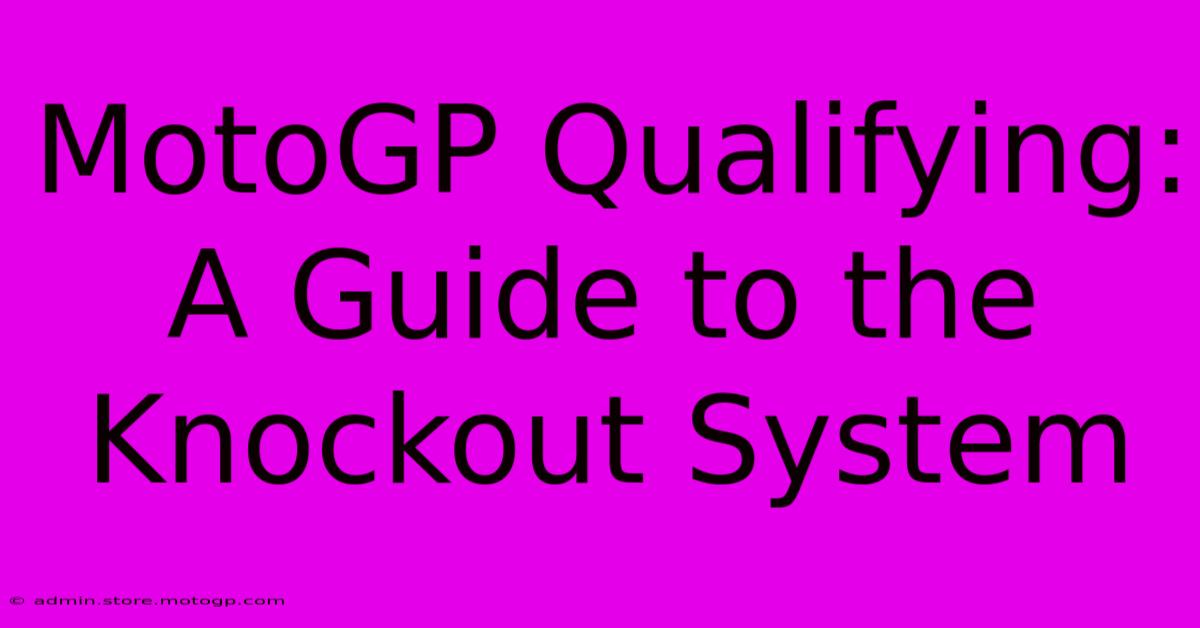MotoGP Qualifying: A Guide To The Knockout System

Table of Contents
MotoGP Qualifying: A Guide to the Knockout System
MotoGP racing is exhilarating, but the drama doesn't just unfold on race day. The qualifying sessions are a crucial part of the spectacle, determining starting grid positions and often setting the tone for the Grand Prix itself. This guide will break down the intricacies of the MotoGP qualifying system, explaining how the knockout format works and why it's so important.
Understanding the MotoGP Qualifying Format
MotoGP qualifying uses a knockout system, also known as a Q1 and Q2 format. This creates a thrilling and competitive atmosphere where riders fight for every tenth of a second. The system aims to separate the fastest riders from the rest, ensuring the front row of the grid is filled with the most deserving contenders.
Q1: The First Knockout
The qualifying session begins with Q1, where the slower riders from the Free Practice sessions (FP1, FP2, and FP3) are grouped together. Essentially, it's a battle for survival. Only the top two riders from Q1 progress to the next round, Q2. The remaining riders start the race from positions 13-24. The pressure is immense, as even a small mistake can mean the difference between a decent starting position and a difficult race from further down the field.
Q2: The Fight for Pole Position
Q2 is where the real fireworks begin. This session features the top ten riders from the combined Free Practice times, plus the two fastest riders who successfully navigated Q1. For 12 minutes, these riders fight tooth and nail to secure the best possible starting position. The rider with the fastest lap time earns the coveted pole position, securing the best starting spot on the grid. This gives them a significant advantage at the start of the race, often crucial for victory.
The Importance of Qualifying in MotoGP
The qualifying session's importance cannot be overstated. A good qualifying performance significantly impacts the race outcome:
- Starting Position Advantage: Pole position provides a significant advantage, allowing the rider to control the race start and avoid early-race chaos.
- Race Strategy: A strong qualifying result influences race strategy. Riders starting further up the grid may adopt different strategies compared to those starting further back.
- Momentum and Confidence: Qualifying well builds confidence and momentum, setting the stage for a strong race performance. A poor qualifying performance, however, can put a rider on the back foot from the very start.
- Championship Implications: Every point counts in the championship battle. Consistent strong qualifying performances are a crucial element of a successful season.
Factors Affecting MotoGP Qualifying Performance
Several factors influence a rider's qualifying performance:
- Rider Skill: A rider's skill and experience are paramount. They need to be able to push their machine to the absolute limit while maintaining control.
- Motorcycle Setup: The bike's setup is critical. Even small adjustments can significantly impact lap times.
- Track Conditions: Weather, temperature, and track surface all affect performance. Adaptability is key to success.
- Tire Choice: Choosing the right tires for the qualifying session is a crucial strategic decision. Different tire compounds offer different levels of grip and durability.
Mastering the Art of MotoGP Qualifying
MotoGP qualifying is a complex dance of skill, strategy, and technology. Success demands precision, focus, and a deep understanding of the machine and the track. The qualifying sessions are a microcosm of the entire MotoGP experience: intense, unpredictable, and ultimately thrilling for both the riders and the spectators.
By understanding the Q1 and Q2 format, the importance of pole position, and the factors influencing performance, you can fully appreciate the intensity and strategic depth of MotoGP qualifying. It's not just a warm-up for the main event; it's a crucial battle in itself, setting the stage for the Grand Prix showdown.

Thank you for visiting our website wich cover about MotoGP Qualifying: A Guide To The Knockout System. We hope the information provided has been useful to you. Feel free to contact us if you have any questions or need further assistance. See you next time and dont miss to bookmark.
Featured Posts
-
Unlock Seamless Parking Your Formula 1 Pass
Feb 19, 2025
-
The Fastest Of Them All Who Won The Grand Prix
Feb 19, 2025
-
F1 Cota Qualifying The Grid Awaits
Feb 19, 2025
-
Your Stress Free Guide To Cota Parking
Feb 19, 2025
-
Moto2 2025 A Season Of Unexpected Twists And Turns
Feb 19, 2025
